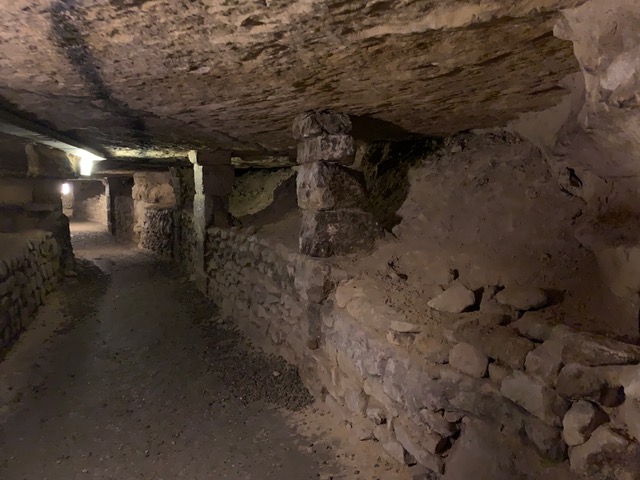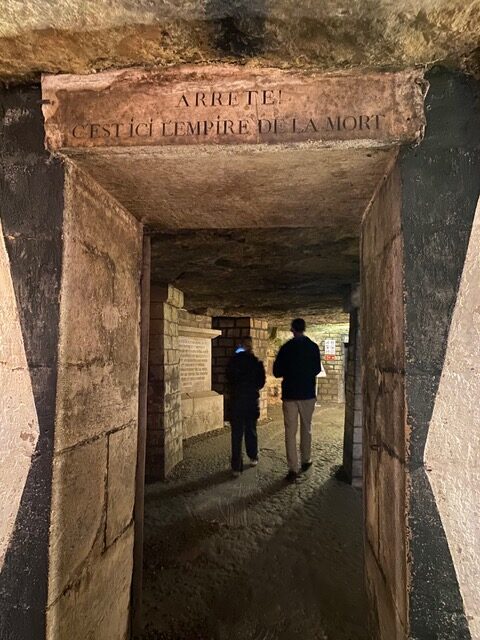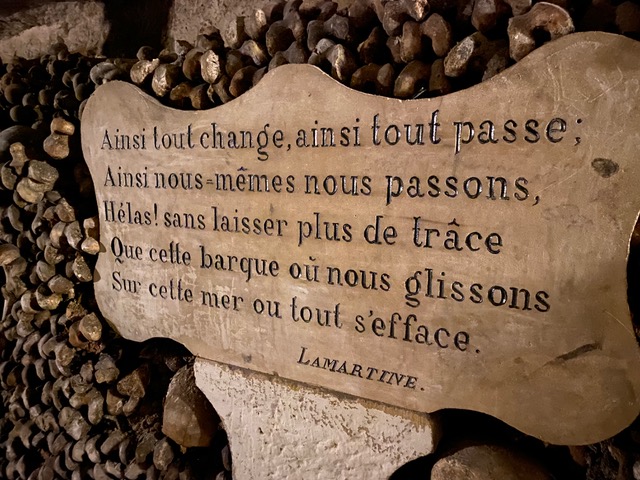
By Donna McEwen
 The Pantheon in the 5th arrondissement, the Latin Quarter, above the catacombs
The Pantheon in the 5th arrondissement, the Latin Quarter, above the catacombs
For someone not familiar with Paris, what would YOU suggest visiting? I love to ask friends and strangers this question and have gathered a very eclectic and interesting list of places to explore in the la Ville Lumière. On a recent flight to Paris, a fellow passenger mentioned that she had found a tour of the catacombs fascinating. Our discussion triggered a memory of a book. Back in 2019, I had read Claire Dickinson’s murder mystery, “City of Dark–The Danger Comes from Below,” and was delighted to find it still available on my Kindle. This book would be the perfect reading material while we visited the city above and eventually got to visit the catacombs below.
Dickinson’s introduction sets the scene for our trek underground: “Paris stands on a void. Before the city could be built, the earth first had to be gutted. The stone blocks of the Louvre and Notre-Dame came from underground quarries below the city. Material was torn from the city’s bowels to erect churches, administrations, and homes.
Today 300 kilometers of underground tunnels pay tribute to a millennium of urban expansion. Popularly known as the catacombs, this vast network of quarry tunnels is situated at a depth of roughly 20 meters below street level. It is illegal for any unauthorized person to enter the catacombs, and most entry points in the city center have been sealed. Nonetheless, an estimated 15,000 people manage to gain access and visit this subterranean world every year.
The most avid visitors return regularly and are known as cataphiles. Their freedom of movement is hindered only by the constant patrols of cataflic police, who ensure the area is kept safe. Likewise, engineers from the quarry inspectorate oversee the structural integrity of the network, which is under threat both from inevitable signs of erosion and wonton acts of malice. Their work is essential. After all, if the tunnels were to collapse, the land above would sink into the ground and the most beautiful city on earth would instantly turn to rubble.”
We were smitten by Dickinson’s words, and any hesitations we had about visiting this ancient site instantly vanished. We needed to discover more!
As we lined up in the pouring rain, seeing tourists being turned away for arriving 20 minutes too early, after being barked at by security agents, and having our tickets refused the first time around (NB Make sure to order tickets from the official catacomb website), we started to question the wisdom of doing this visit. However, I’m glad we stuck it out since the whole experience proved to be very moving and informative. It also helped us to understand better how a notorious character in “City of Dark,” the Nightingale, managed to stay undetected hidden underground while he accomplished his deadly tasks.
We opted for the self-guided audio tour rather than the in-person guided tour. This turned out to be the best choice. As others in our time slot were hurried from one site to the next, we took our time, reading every panel, taking a few pictures, and soon found ourselves almost alone in many sections of the underground network, dotted with engraved stones, indicating inspection dates and quotations by great authors over the centuries. These quotations pointed out the fleeting nature of life, which was only accentuated by the thousands upon thousands of human remains, meticulously piled row upon row. The first glimpses took my breath away and I wondered what the individual stories of each person from so long ago might be. What caused their deaths centuries earlier? Some famous people’s stories were explained, but not the vast majority.



Young girl listens intently to the audio tour by a water well
As early as the 1780s, there had been reports of heavy buildings collapsing into the empty quarries below. Something needed to be done. The municipal ossuary was created in 1785-1786, when the first transfer of bones was organized to evacuate the Cemetery of Holy Innocents in the center of Paris. Citizens had been worried about diseases from the cemetery spreading amongst the population. Bones continued to be moved to the site up until 1814, and later around 1860. The empty abandoned quarries were easily accessible and still located outside Paris at the time, at a safe distance from population.



Disinterment of the graves in Cemetery of Holy Innocents to more distance sites
Thirteen years later, a quarry inspector, Louis-Etienne François Héricart de Thury, transformed the ossuary into a walkway museum, arranging the bones in decorative patterns, following a medieval tradition of ossuaries and mass graves.


“STOP! This is the empire of death.” / skulls arranged in a heart shape
It’s easy to see why generations of people have found the tunnels of the catacombs intriguing, irresistible, and felt drawn to explore them on their own, even if this exploration is mostly illegal. In Claire Dickinson’s “City of Dark,” Antonia (Toni) Corrigan, a young engineering student from Montreal, has access to enter the catacombs, as well as extensive knowledge of the sections not normally open to the public. Her knowledge proves invaluable to Inspecteur Général Sadiqi as together they try to track down the Nightingale, who seems connected to several murders and to a young traumatized cataphile. Whose knowledge will hold the key in this quest for to stop the mayhem above?
For this article, the author generously accepted to do a WhatsApp interview about her book. Claire Dickinson has been involved in an association for the protection of underground Paris, interested in preserving the delicate structures in this ancient section of the city, so has had the opportunity to attend catacomb events connected to that group. Born in Canada, she has lived in Paris most of her life and is working on a sequel to “City of Dark,” with more on the catacombs.
Open to the public for over two centuries, the Catacombs site is now managed by the Carnavalet – Histoire de Paris Museum, which continues to protect and enhance its fragile heritage. The organic nature of the bones, their weakening due to being transferred and exposed, the too humid climate and the cement used in the past to stabilize the walls are all obstacles in their conservation. Some of these problems are discussed in “City of Dark” as the characters in the story find passages sealed off by cement used to make constructing buildings above easier and cheaper.
“City of Dark” is a well-researched book, taking the reader through political intrigue, murder, mystery, freemasonry, and terrorism, in a fast-paced plot that is very readable. In fact, the novel is difficult to put down, once started. This is an excellent way to discover some of the history of the city of Paris from above ground and from below. Sites in the Latin Quarter such as the Pantheon, le lycée Henri IV and Val de Grace military hospital take on a new light as the story unfolds.
Looking at the maps of the catacombs, we realized that much of the action in the book happens directly beneath our feet, close to our rented apartment in the 5th arrondissement. What else is happening 20 meters below our strolls? Will we ever know?



(translation) Thus everything changes, everything passes; so, we ourselves pass, alas! without leaving any more trace than this boat which slides on the sea, and where all disappears. LaMartine






